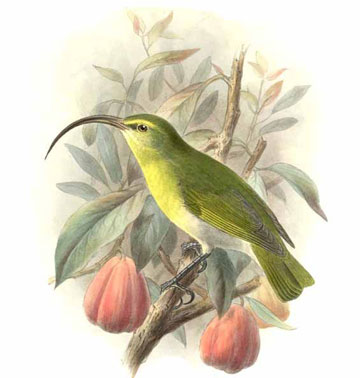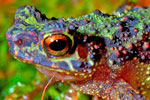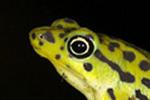Imagine if your job was to locate extinct species. In 2010, biologists with The Search for Lost Frogs set out on a tropical mission hoping to confirm the existence of frog species not seen in decades. The team recovered proof of four out of a hundred missing species, including a toad among the expedition’s Top Ten Amphibians list. According to a new study study in the open access journal PLoS ONE, such biological surveys are critical conservation tools to prevent the ‘romeo error’: the abandonment of conservation efforts due to belief that a species is extinct. The study, the first of its kind, found that rediscovered species are especially in danger of vanishing again, this time altogether, without targeted conservation measures.
Looking only at species that had once been thought globally extinct, researchers classified rediscoveries in three ways: species that had been declared extinct, species without confirmed sightings for a significant period of time, and re-sightings of species confirmed only once. The majority of rediscovered species fell in the latter two categories. Altogether, the research team recorded 351 extant species rediscovered over the last 122 years: 144 birds, 104 amphibians, and 103 mammals. On average, species went missing 61 years before being rediscovered, but some were lost for up to 331 years. Biologists and alert citizens located the majority of these species, largely in the tropics. Amphibians considered extinct were rediscovered almost exclusively at high elevations (greater than 1000 m), while rare birds and mammals were found in lowlands and foothills.
 Illustration of the greater Akialoa, rediscovered and then lost again for good. The last record was 1969. Illustrated by: Johannes Gerardus Keulemans. |
While the rediscovery of species thought to be extinct should provide hope to the conservation movement, the researchers caution that optimism for the continued survival of rediscovered species is premature: many of the 351 romeo species are likely to die out without aggressive conservation efforts—some, like the greater Akialoa (Hemignathus ellisianus, a large Hawaiian bird with a remarkably long beak, already have. The research team is confident many more species currently declared extinct by experts are in fact extant—but may not be relocated in time to save. Without confirmation of their existence, these species will not be protected.
“Rediscoveries, without aggressive conservation, likely represent the delayed extinction of doomed species and not the return of viable populations. In short, there is hope but we must step up rapid conservation efforts,” warns lead researcher Brett R. Scheffers of the Department of Biological Sciences at the National University of Singapore.
To determine the threat of extinction of species already on the brink, the team used the International Union for Conservation of Nature (IUCN)’s threat categories: Extinct, Extinct in the Wild, Critically Endangered, Endangered, Vulnerable, Near Threatened, Least Concern, and Data Deficient. The current threat level for rediscovered species is several times higher than for other species in each taxonomic class: overall, 86 percent of rediscovered species are threatened with extinction. The study also determined species missing for a short amount of time before being located are every bit as threatened as those unseen for decades.
Biological surveys like The Search for Lost Frogs and Conservation International’s Rapid Assessment Program (RAP) are crucial for conservation because they confirm population densities and sometimes reveal new species—and species thought to be extinct. While such confirmations are a cause for celebration, these species are far from safe from permanent eradication.
According to scientists, a sixth planetary mass extinction is ongoing. The IUCN estimates that 30 percent of amphibians, 21 percent of mammals, and 12 percent of birds are extinct or gravely threatened. Habitat loss, climate change, over-harvesting, invasive species, and the wildlife trade are responsible for most biodiversity loss.
CITATION: Brett R. Scheffers, Ding Li Yong, J. Berton C. Harris, Xingli Giam, Navjot S. Sodhi. The World’s Rediscovered Species: Back from the Brink?. PLoS ONE.
Related articles
First ever picture of long lost rainbow toad

(07/13/2011) Scientists are elated after the surprise rediscovery of a wildly-colored frog not seen for 87 years and never before photographed—until now. The Bornean rainbow toad, also known as the Sambas Stream toad (Ansonia latidisca) was rediscovered on Borneo in the Malaysian state of Sarawak by local scientists inspired by a 2010 search for the world’s missing amphibians by Conservation International (CI). Leading up to its search CI released the World’s Top 10 Most Wanted Lost Frogs (out of a hundred being searched for): the Bornean rainbow toad was listed as number 10.
Red rodent shows up at Colombian nature lodge after 113 years on the lam
-ProAves-2.150.jpg)
(05/18/2011) The red-crested tree rat (Santamartamys rufodorsalis) had not been recorded since 1898 and was thought possibly extinct—that is until one showed up at 9:30 PM on May 4th at a lodge in El Dorado Nature Reserve in northern Colombia. ‘He just shuffled up the handrail near where we were sitting and seemed totally unperturbed by all the excitement he was causing,’ said Lizzie Noble, a British volunteer with Fundacion ProAves.
Researchers rediscover one of the world’s most sought-after lost frogs

(02/17/2011) The Search for Lost Frogs, a global expedition to uncover amphibian species not seen for decades, has uncovered one of the expedition’s most sought-after species: the Pescado stubfoot toad (Atelopus balios). The discovery in Ecuador was one bright spot in a search that revealed more about the crisis and extinctions of frogs than it did about the hopefulness of finding cryptic communities. In total the expedition rediscovered 4 of its 100 targeted species.